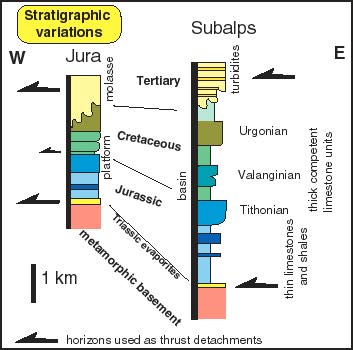
| Return to contents page |
The stratigraphy of the Jura and Subalpine chains shows marked lateral variations. In
the west (Jura) the Mesozoic rocks are dominated by thick limestone units with very few
intervening shales. They were deposited in a stable platform environment, building up
about 2 km of rock section during the Jurassic and Cretaceous. These limestones are capped
by an angular unconformity (subtle) above which were deposited the molasse sandstones and
conglomerates. In contrast, further to the east the Mesozoic succession is thicker and
more shale-prone. Although there are thick limestone units they are separated by shale
units. In the east these sediments were deposited in a slowly subsiding basin, building up
over 4 km of rock section. These basin sediments are overlain by Tertiary siliciclastic
units, especially turbidite succession (termed "flysch" in Alpine literature).
The different stratigraphic successions (west and east) might be expected to have
different mechanical properties and thus show different types of deformation structure.
This prediction can be investigated as you visit the different field locations in this
site.

| Return to contents page |